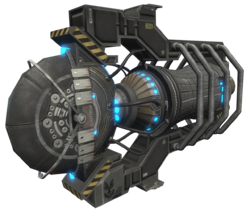Slipspace drive: Difference between revisions
From Halopedia, the Halo wiki
(→Trivia: Unique to S-F drive) |
|||
| Line 10: | Line 10: | ||
==Covenant== | ==Covenant== | ||
[[File:Covenant Slipspace Drive.jpg|thumb|right|150px|An ''Ophon''-patttern Borer.]] | |||
Being more technologically advanced than humanity, the [[Covenant]] have numerous advantages in slipspace propulsion systems. Whilst the human Shaw-Fujikawa engine is said to “punch” a hole between realms using brute force, Covenant engines instead take a small rupture and delicately enlarge it with surgical precision. This allows the latter to execute far more accurate slips.<ref>'''[[Halo: First Strike]]''', ''page 86''</ref> Covenant slipspace drives are often referred to as "jump drives".<ref>'''Halo: Contact Harvest''', ''page 136''</ref> In addition to their more powerful [[Repulsor engine|thruster engines]], it has been theorized by the UNSC that Covenant drives generate several "microjumps" within a single slipspace transition to measure the dilation involved in a jump, allowing them to reach their destinations faster.<ref>'''Halo: First Strike (2010)''', ''[[Tug o' War]]''</ref> | |||
Covenant drives are generally more flexible and powerful than those of humans. They have thrice been seen to execute in-atmosphere slipspace transitions<ref>'''[[Halo: First Strike]]'''</ref><ref>'''[[Halo 2]]''', level ''[[Delta Halo (level)|Delta Halo]]''</ref> (although the first time the drive in question was controlled by [[Cortana|a human AI]]). In addition, Covenant drives can execute successful slips even if underpowered. | |||
===Known Borers=== | |||
*''Ophon''-pattern - Used on the ''Ket''-pattern [[CCS-class battlecruiser]]. | |||
*''Primus''-pattern - Used on the ''Kerel''-pattern [[CAS-class assault carrier]]. | |||
*''Tyros''-pattern - Used on the [[SDV-class heavy corvette]]. | |||
==Forerunner== | ==Forerunner== | ||
Revision as of 13:05, February 13, 2018
- "They have opened a path to the stars for all of us."
- — Dedication to Tobias Fleming Shaw, ScD, QeD, FRS (January 30, 2220–November 10, 2317), and Wallace Fujikawa ScD, QEnD (April 20, 2215–February 18, 2318)[1]
The slipspace drive is a spacecraft propulsion system capable of making transitions to and from slipstream space and by extension allowing faster-than-light interstellar travel. The device functions by creating ruptures between normal space and slipspace. The nonstandard physics of slipspace allow it to be used as a shortcut realm, facilitating interstellar travel between distant regions in reasonable time.[2]
Human
Humans created the Shaw-Fujikawa Translight Engine.
 This section needs expansion. You can help Halopedia by expanding it.
This section needs expansion. You can help Halopedia by expanding it.
Covenant
Being more technologically advanced than humanity, the Covenant have numerous advantages in slipspace propulsion systems. Whilst the human Shaw-Fujikawa engine is said to “punch” a hole between realms using brute force, Covenant engines instead take a small rupture and delicately enlarge it with surgical precision. This allows the latter to execute far more accurate slips.[3] Covenant slipspace drives are often referred to as "jump drives".[4] In addition to their more powerful thruster engines, it has been theorized by the UNSC that Covenant drives generate several "microjumps" within a single slipspace transition to measure the dilation involved in a jump, allowing them to reach their destinations faster.[5]
Covenant drives are generally more flexible and powerful than those of humans. They have thrice been seen to execute in-atmosphere slipspace transitions[6][7] (although the first time the drive in question was controlled by a human AI). In addition, Covenant drives can execute successful slips even if underpowered.
Known Borers
- Ophon-pattern - Used on the Ket-pattern CCS-class battlecruiser.
- Primus-pattern - Used on the Kerel-pattern CAS-class assault carrier.
- Tyros-pattern - Used on the SDV-class heavy corvette.
Forerunner
 This section needs expansion. You can help Halopedia by expanding it.
This section needs expansion. You can help Halopedia by expanding it.
Trivia
- In real-world physics, black holes have been identified as a possible vector for constructing traversable wormholes, specifically through the use of the Kerr metric.
List of appearances
|
|
Sources
- ^ Halo 3, multiplayer level Orbital
- ^ Halo: The Fall of Reach, page 141
- ^ Halo: First Strike, page 86
- ^ Halo: Contact Harvest, page 136
- ^ Halo: First Strike (2010), Tug o' War
- ^ Halo: First Strike
- ^ Halo 2, level Delta Halo

